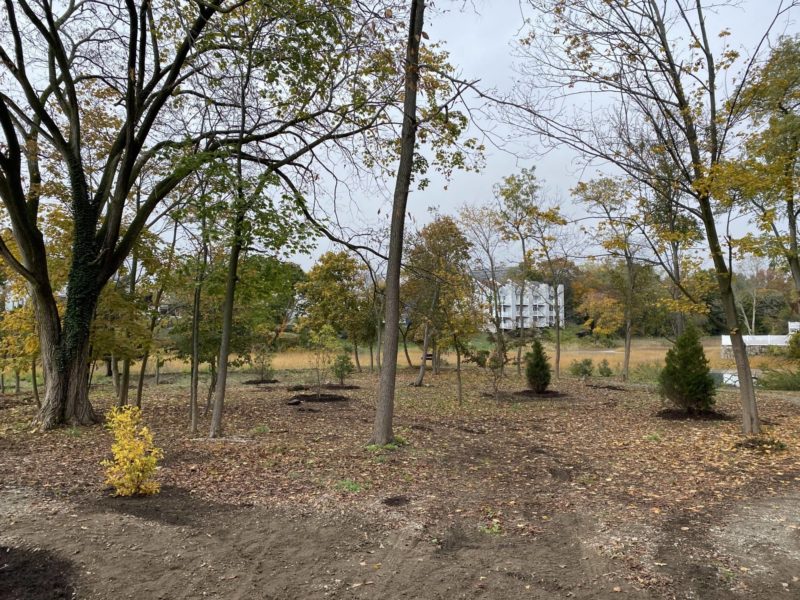
By Matt Viens
Trees, wildflowers, birds, and….mussels? Believe it or not, all are things you can see when visiting a Greenwich Audubon Center sanctuary. While most people are familiar with the forests and fields of the Main Sanctuary and Fairchild Wildflower Garden, it is Greenwich Audubon’s smallest property – the Oneida Sanctuary – that provides visitors with perhaps the most unique experience. And, like David facing off against Goliath, Oneida has an outsized role to play in the resiliency and well-being of Connecticut’s coastal communities.
You’d be forgiven, however, if you’ve never noticed the small open space at the corner of Indian Harbor and Oneida Drive. Donated to Audubon in the late 1970’s as part of a development offset (thanks largely to the efforts of former Greenwich resident Murray Mortimer), Oneida Sanctuary is just 4 acres in size – only one of which is dry land. The remainder of the space comprises saltwater marsh habitat, which becomes periodically submerged during high tide.
Yet Oneida Sanctuary’s modest scope and appearance belie the critical importance of the ecosystem it protects. Coastal habitats such as Oneida are home to several species of native marsh grass and support over 350 types of resident and migratory bird including osprey, saltmarsh sparrow, black duck, and green and great blue heron. Aquatic species such as salt marsh snails, fiddler crabs, shrimp, striped bass, and shellfish such as mussels and oysters also rely on tidal marshes as nurseries and nutrient sources.
Yet the importance of Oneida’s tidal marshes extends far beyond its wildlife and plant communities. Saltwater marshes absorb wave energy and flood water, helping protect coastal communities during storm events. They absorb and filter nitrogen – a common by-product of lawn fertilization – and other pollutants from coastal waters, keeping them safe for recreational enjoyment. And, through the annual growth and dieback of marsh grasses, they play an important role in the capture and storage of atmospheric carbon. What results is a system that helps address one of the key drivers of future global climate change – greenhouse gas emissions – while protecting present-day communities from impacts that are already being felt.
Unfortunately, pressures from land development, climate change, and invasive species pose dire threats to the health and sustainability of Oneida Sanctuary and ecosystems like it. Since 1836 the town of Greenwich has lost roughly 86% of its tidal wetland habitat, due primarily to pressures from commercial and residential development. Oneida itself is threatened by the expansion of invasive plant populations, including common reed (Phragmites australis), mugwort (Artemisia vulgaris), Norway maple (Acer platanoides), and porcelain vine (Ampelopsis brevipedunculata). Furthermore, many of Oneida’s tallest trees have been severely damaged during recent storm events while pressures from deer browse threaten the longevity of younger, healthier plants.
That all adds up to a lot of pressure for a small piece of land. The good news? Staff at the Greenwich Audubon Center and several partner organizations have developed and are working to implement new plans for the restoration and preservation of a revitalized Oneida Sanctuary. Proposed project elements include the treatment of invasive plants, the removal of dead and dying trees, and the planting of 60-65 native trees and shrubs. Through these efforts, Audubon staff will be experimenting with “assisted migration,” wherein species from more southern regions are planted in anticipation of a warmer, wetter future climate. Species being considered include Virginia pine, loblolly pine, Virginia rose, and post oak, with the goal of creating an ecosystem that is resilient now and in a climate-altered future.
In collaboration with the Greenwich Pollinator Pathway program, Audubon staff also aim to restore ¼ to ½ acre of native meadow habitat in support of both bird and insect pollinators. These native plants will help increase productivity and carbon storage, suppress non-native invasives, and reintroduce several species that have been lost at Oneida. Additional discussions are underway to host a seed library within the sanctuary (modelling a similar program at Cos Cob Library), from which residents can take locally collected native seeds for home plantings.
These nature-based objectives are in addition to several community-centric improvements that staff are working to implement. Chief among these is the installation of a 375-foot walking pathway and several seating areas to accommodate visitors of all ages and abilities. New signage at both Oneida Sanctuary and nearby Bruce Park will detail the importance of tidal marsh ecosystems and the animals they support, while a series of public workshops will further inform visitors on topics ranging from coastal bird identification to the management of invasive plants. And an expansion of Audubon’s Habitat and Ecological Land Pro (H.E.L.P.) endorsement program, developed by Senior Coordinator for Bird Friendly Communities Joy Cirigliano, will utilize Oneida as a living classroom to teach residents and landscape professionals about the importance and implementation of ecological, climate-forward stewardship.
None of this happens without support from the community, however. If you’d like to engage with any of the initiatives listed above, visit the Greenwich Audubon Center website to learn about volunteer opportunities, make a donation, and be sure to check out our wonderful community partners.
Our ultimate hope is that, with the help of local stewards like you, Oneida can provide both vibrant wildlife habitat and a hub for community education and recreation. And by serving as a model for the sustainable management of natural ecosystems, Oneida can connect with and help guide coastal restoration efforts at a much broader scale. So let’s think big, start small, and make change together – 4 acres at a time.
Matt Viens is the Manager of Land Stewardship for the Greenwich Audubon Center. In this role, Matt oversees and leads the active management of roughly 700 acres of wildlife habitat across Greenwich, CT. He is an ISA-certified arborist and holds a Master of Environmental Management degree from the Yale School of the Environment.





